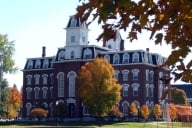You have /5 articles left.
Sign up for a free account or log in.
The recent boom in nursing education is finally showing some signs of slowing, according to a new comprehensive survey of nursing schools -- but not necessarily for lack of student interest. Rather, as a result of the recession, many programs report that there are not enough hospital and clinical spots for them to expand to meet the still-high demand.
Tuesday, the National League for Nursing, an association of faculty and administrators in the profession, released a report chronicling the data it recently obtained for the 2007-8 academic year.
Despite containing all the signs of a nursing education slowdown -- declining admissions and stagnant enrollments -- the report notes that pre-licensure programs are still very competitive and demand for spots in these programs still exceeds capacity at many institutions.
In 2008, the number of applicants to these programs went almost unchanged from the year prior. Nearly 35 percent of pre-licensure programs reported that they received more qualified applicants than they could accept. On the ground, this means than 119,000 qualified students -- 39 percent of all qualified applicants -- were turned away from these programs.
Nursing programs that turned away qualified applicants were asked "to identify the primary obstacle to expanding admissions.” More than a lack of faculty or classroom space, administrators of pre-licensure programs reported that the “lack of clinical placement settings” was the primary reason they could not admit more students.
The nursing program at Hudson Valley Community College, just north of Albany, is one of the colleges facing these obstacles. Drew Matonak, president of the two-year college in the State University of New York System, said that his nursing program has a waiting list on which the average interested student spends two years.
Last semester, the college served 310 nursing students. This semester, Matonak succesfully lobbied the Albany Medical Center, a nearby hospital and employer of many Hudson Valley nursing graduates, to pay for half of the cost of increasing the program's size by 75 students. The program will remain at its new, expanded capacity, he said, until more places are found for students to do clinical work and more funds are raised to hire new faculty.
In what Kathy A. Kaufman, senior research scientist at the NLN and author of the new report, dubs “a surprising turnaround,” admissions to pre-licensure nursing programs fell in 2008 for the first time in six years. New admissions were down by nearly 2 percent for all types of pre-licensure programs: associate degree, bachelor degree and hospital-based diploma programs. Admissions in these programs had grown annually since 2003.
| Year | Number of Admissions to Pre-licensure Nursing Programs | Percent Change |
| 2003-4 | 145,410 | 9.3% |
| 2004-5 | 152,627 | 5.0% |
| 2005-6 | 166,442 | 9.1% |
| 2006-7 | 181,862 | 9.3% |
| 2007-8 | 178,354 | -1.9% |
In another “turnaround,” the report notes that, also for the first time in six years, enrollments in prelicensure nursing programs were relatively flat in 2008. Still, graduations in these programs did increase by nearly 12 percent in 2008, although Kaufman writes that this is likely “a lagging effect of the upsurge in admissions between 2003 and 2008.”
| Year | Enrollment in Pre-licensure Nursing Programs | Percent Change |
| 2003 | 244,769 | 10.4 % |
| 2004 | 281,141 | 14.9 % |
| 2005 | 290,309 | 3.3 % |
| 2006 | 292,238 | 0.7 % |
| 2007 | 314,431 | 6.5 % |
| 2008 | 315,524 | 0.3% |
Not only did the flow of students into nursing programs slow in 2008, but Kaufman also noted that the growth in the number of pre-licensure programs “ground to a near halt.” Between 2007 and 2008, only 15 such programs were added across the country. This constitutes less than a 1 percent increase and stands in stark contrast to the almost 10 percent growth in 2006 and nearly 4 percent growth in 2007.
| Year | Number of Pre-licensure Nursing Programs | Percent Change |
| 2006 | 1,694 | 9.7 % |
| 2007 | 1,758 | 3.8 % |
| 2008 | 1,773 | 0.9 % |
"What we're seeing is the impact of the recession on the ability of programs to accommodate more students," Kaufman said in an interview. "I expect for the number of programs not to increase all that much in the coming years."
Though NLN has collected data for 2008-9, Kaufman said that data has yet to be analyzed. Still, she expects that as NLN looks at data covering the heart of the recession, admissions and enrollments will remain relatively flat. She predicts that graduation, a lagging indicator, will continue to fall in the coming years.
Despite the dour news about declining clinical opportunities hindering entrance into pre-licensure nursing programs, Kaufman said, there are a number of initiatives underway around the country to expand these placement opportunities. For example, she noted that some programs are experimenting with "simulated" clinical trails in high-tech workrooms to supplement, rather than substitute for, real-world hospital placements. Such options, however, are expensive and have been slow to catch on in recent years because of their cost.








